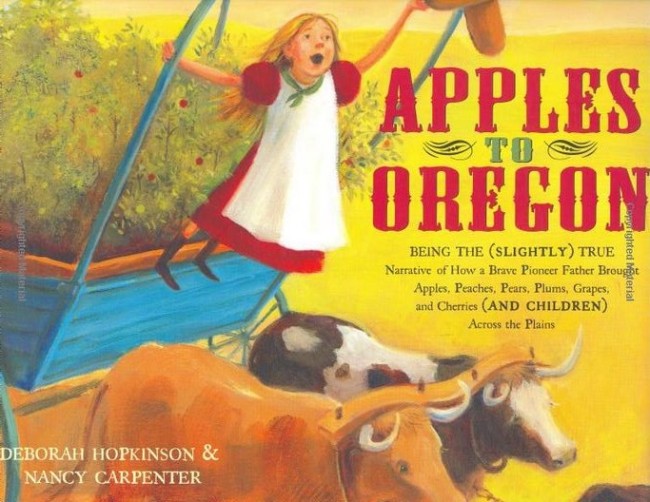My first exposure to the Oregon Trail was playing the video game on my parents’ computer in the early 1990s. Apples to Oregon by Deborah Hopkinson and Nancy Carpenter follows the route I learned so well without any of the dreaded illness, drowning, or running out of food. The book does include those beloved landmarks of Courthouse Rock and Chimney Rock and the perils of crossing the Platte River. Even better, the book is such a rich, colorful experience compared to the black and white game I loved so much.
While this book is based on the historical Oregon Trail, it is told as a tall tale from the point of view of Delicious, the daughter of a pioneer who is bringing his fruit trees from Iowa to Oregon. He worries about the survival of his saplings along each peril of the journey. And Delicious makes a scrumptious heroine as she saves the apples.
The book is a gold mine of figurative language. Hyperbole, idioms, similes, metaphors, alliteration, and personification – this book is great for reading and rereading to analyze the excellent use of figurative language. For example, the climax of the book is Delicious’s personified battle against Jack Frost where in the end “that low-down scoundrel was hightailing it out of there.”
Phrases like “muddier than a cowboy’s toenails” and “I spied a foul-looking bunch of clouds stomping around the sun just fit to be tied” make the book a fun read; one that is wonderful to read aloud. The book is appropriate for k-6, but will be most enjoyable to students with background knowledge about the Oregon Trail.
While the book is best classified as a tall tale, it is also historical fiction. The book is inspired by Henderson Luelling who did bring the first apple trees to Oregon in a covered wagon along with his wife and eight children.
Apples to Oregon Discussion Questions Based on Common Core Reading: Literature Standards:
- Who is the narrator of the book?
- What were some of the major problems the family experienced on their journey to Oregon?
- How would you describe the tone of the book? Is it serious, funny, sad…why?
- Look at the first picture of the covered wagon on the way to Oregon. What do you notice about the wagon? What does this tell you about the family?
- Delicious is the hero of this book. What actions does she take that make her a hero?
- This book is a tall tale. The definition of a tall tale is story that has unbelievable or exaggerated events that are told as if true. Many tall tales are set in the American frontier. Give examples of why this book fits the definition of a tall tale.
- Pick a page or two of the book to reread. What language is used to make the page interesting?
